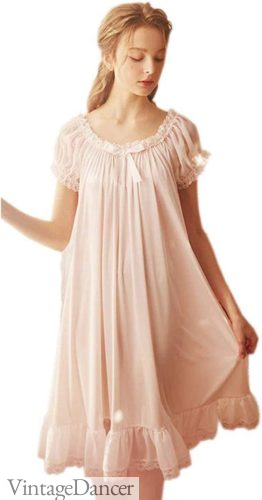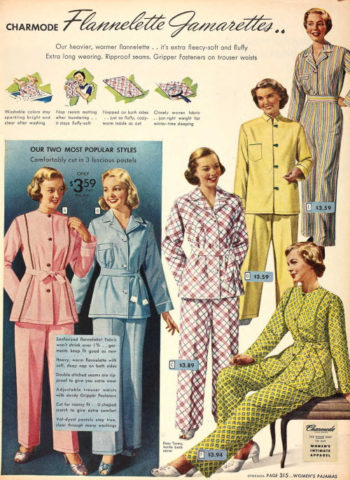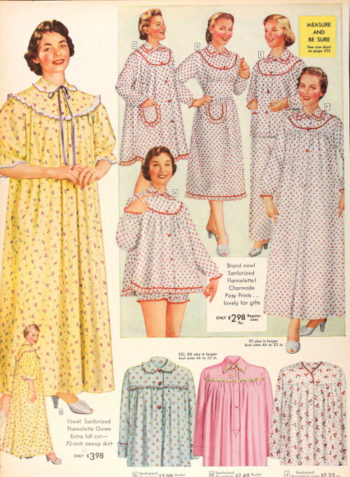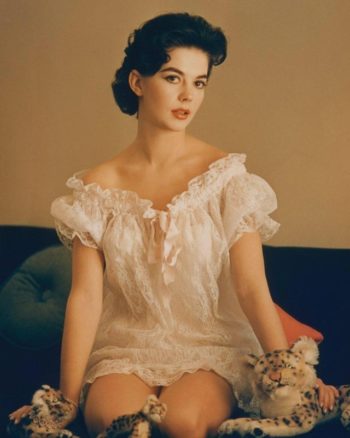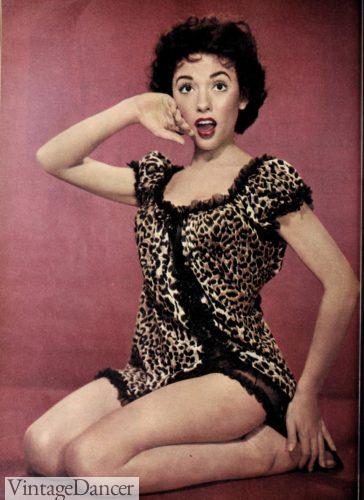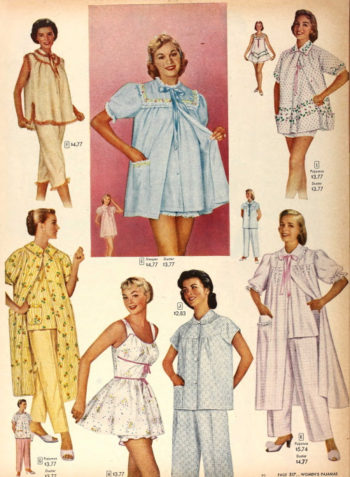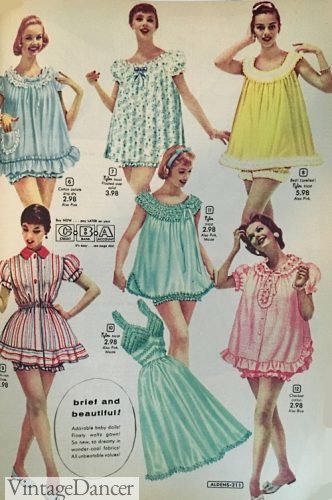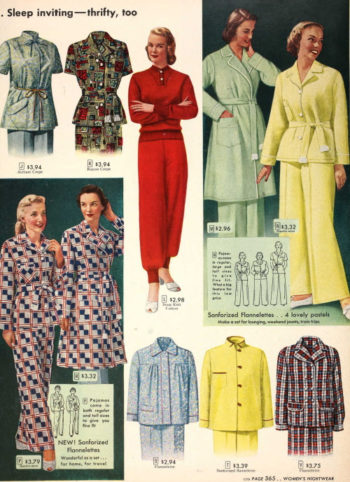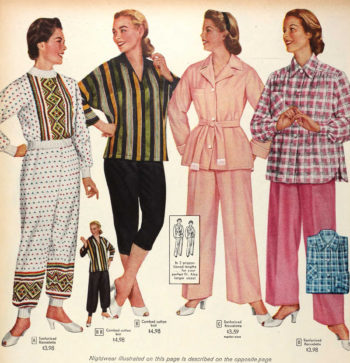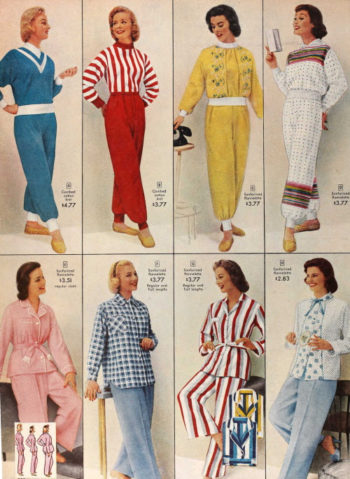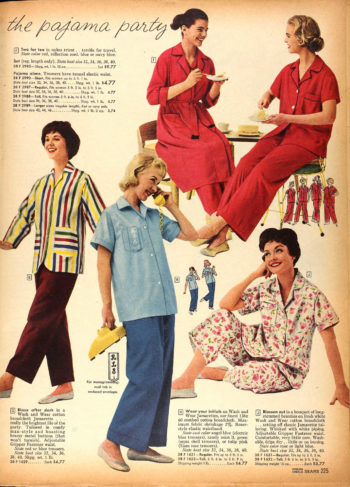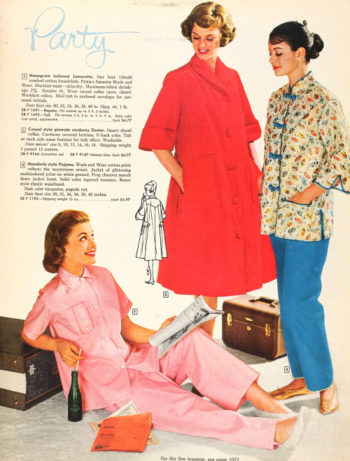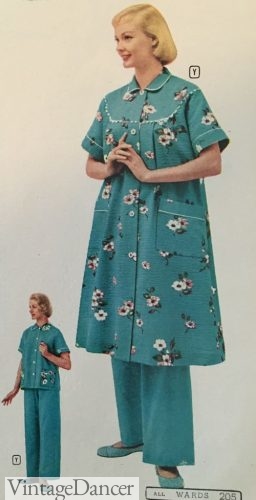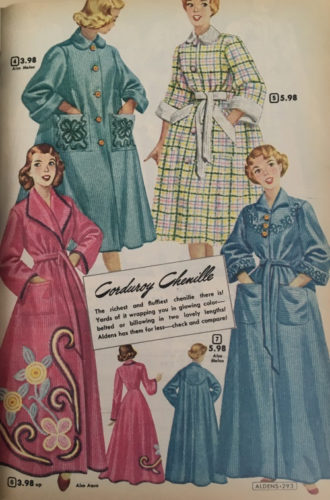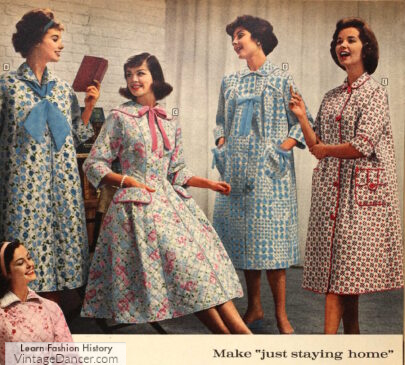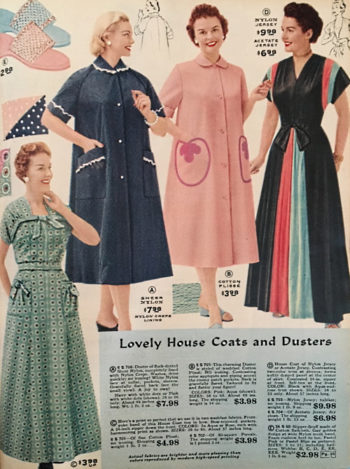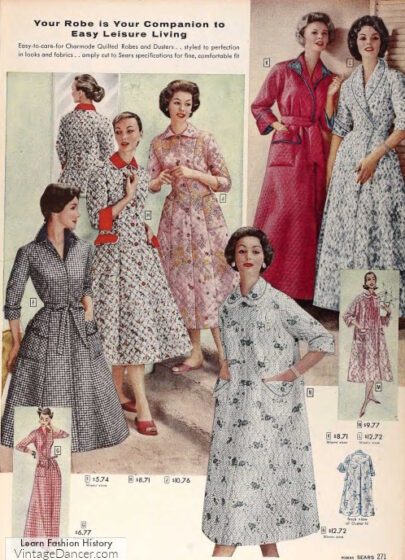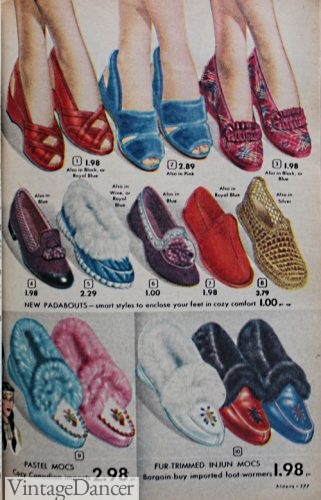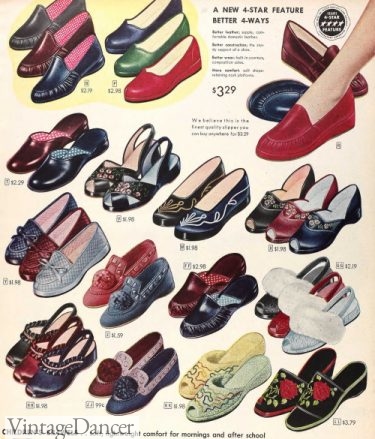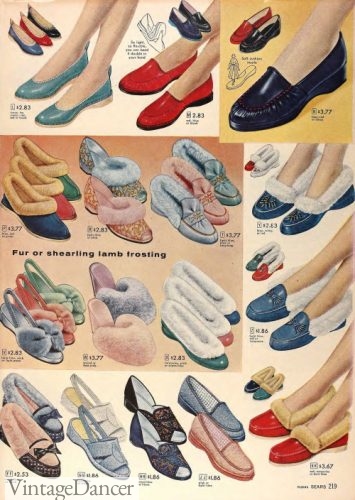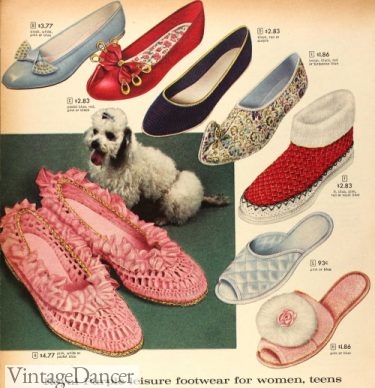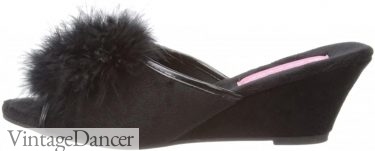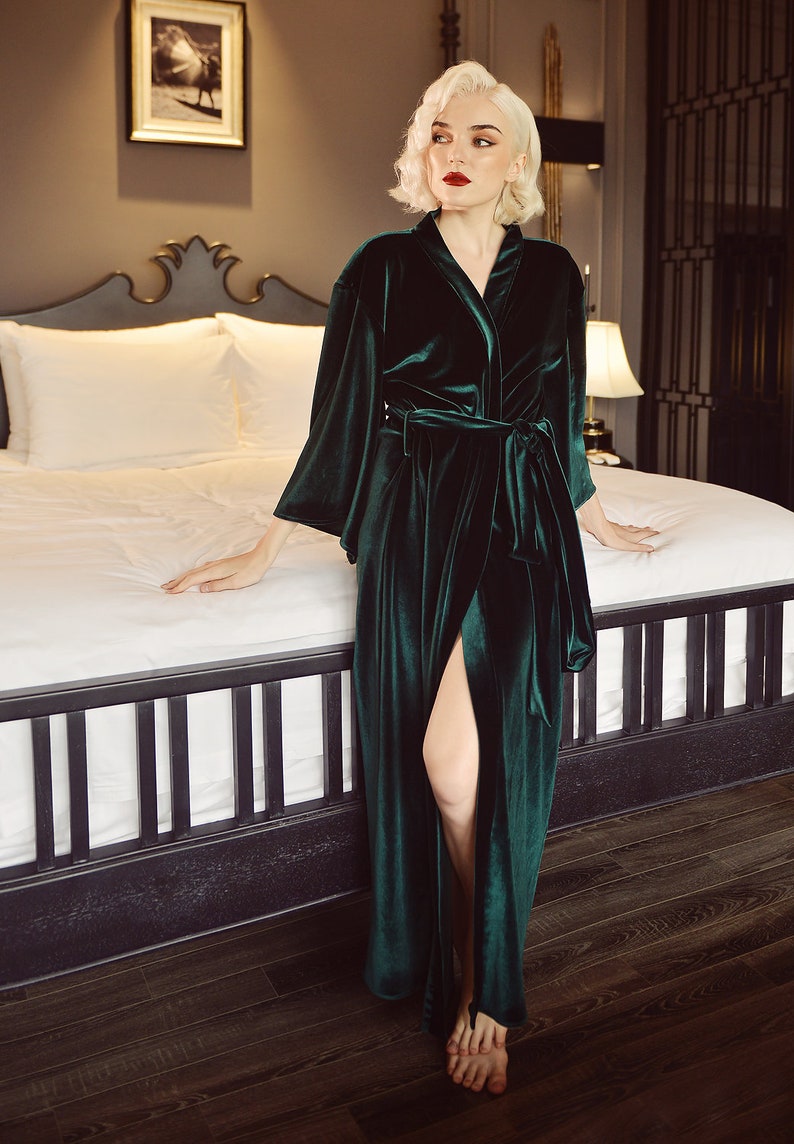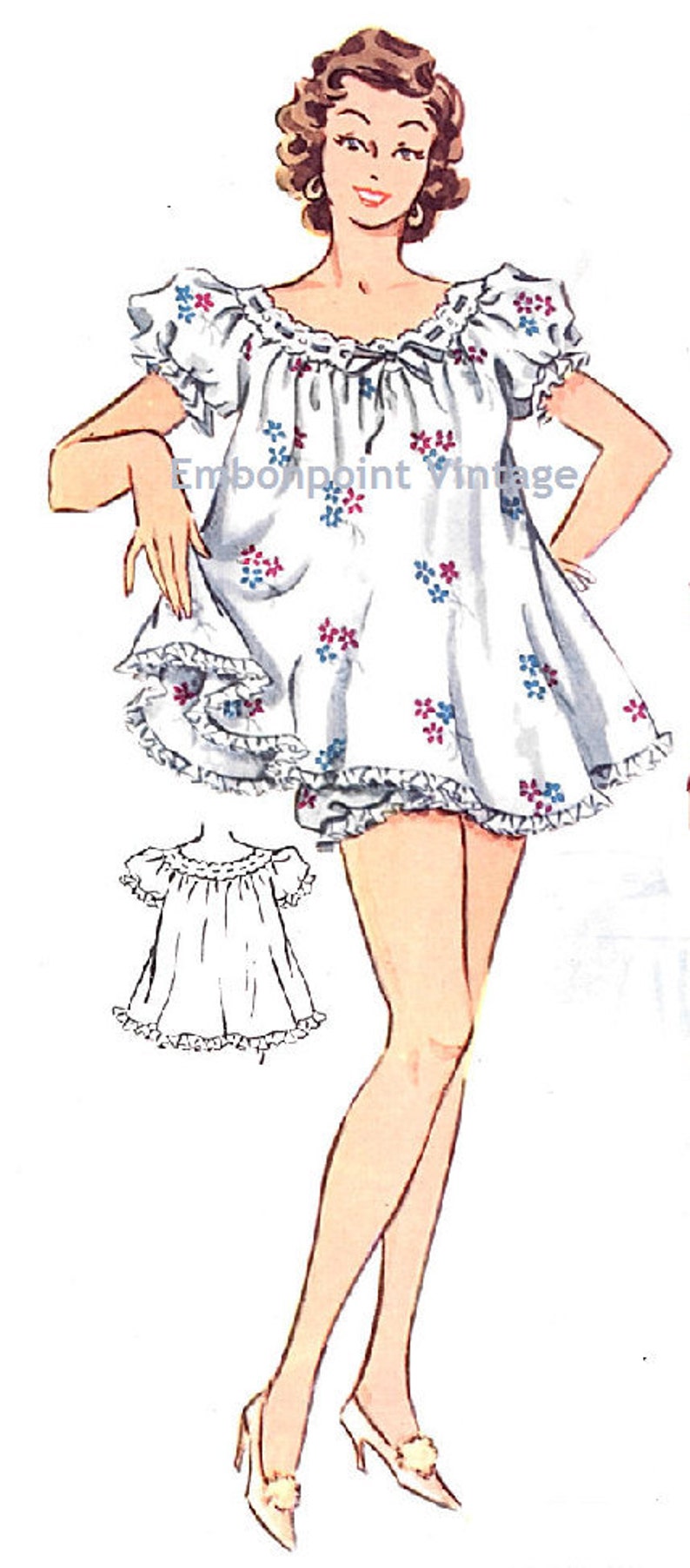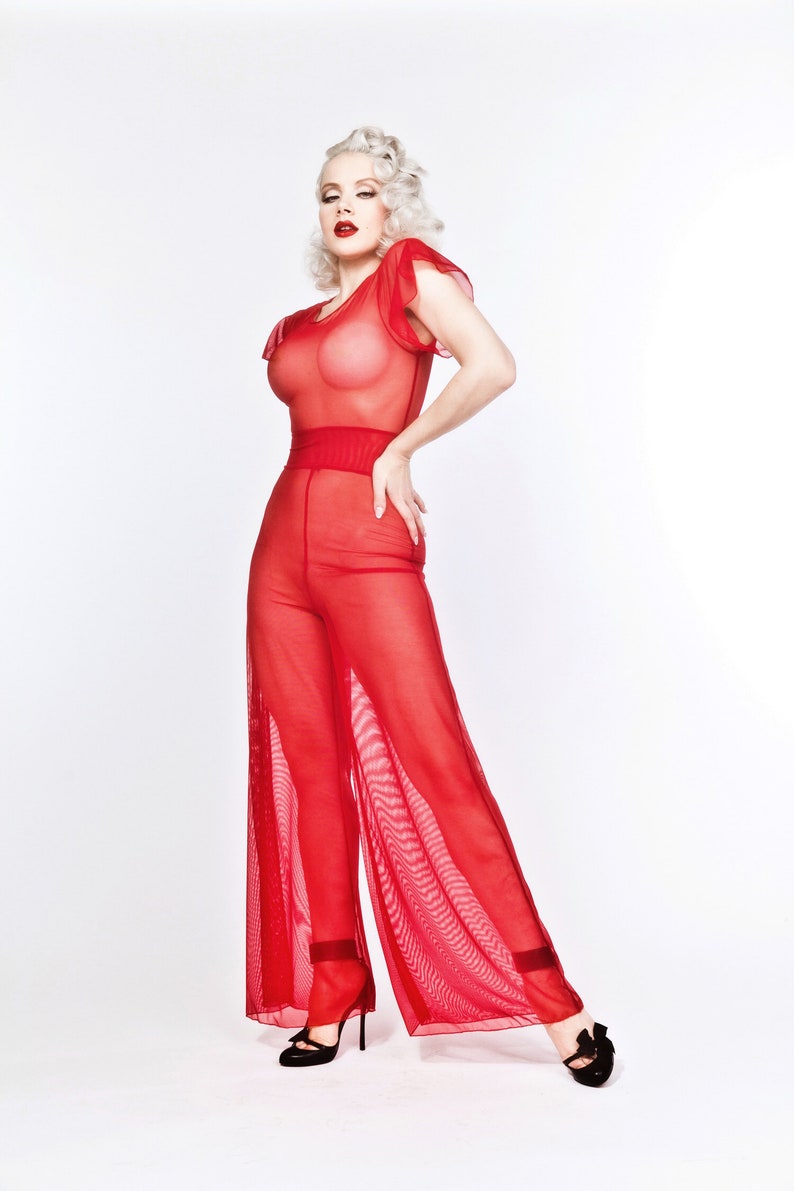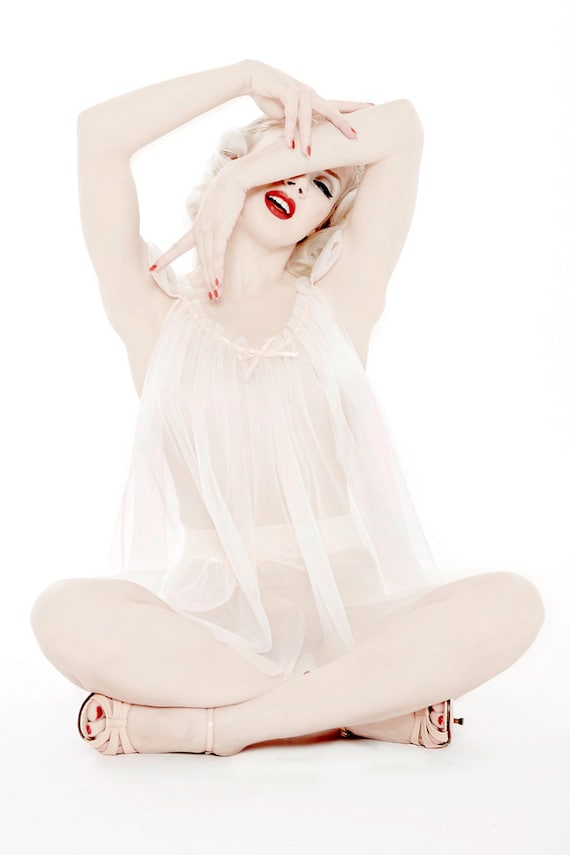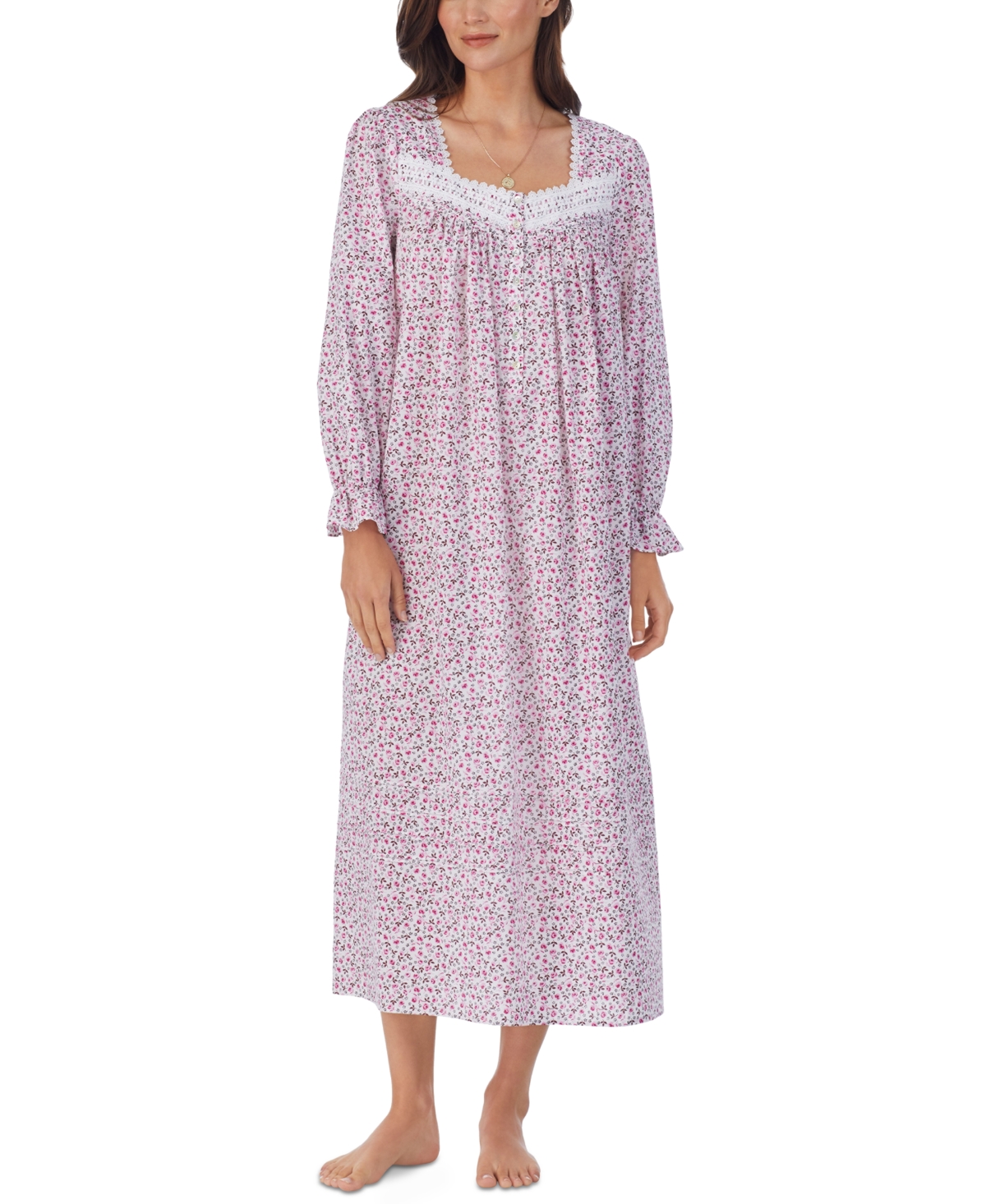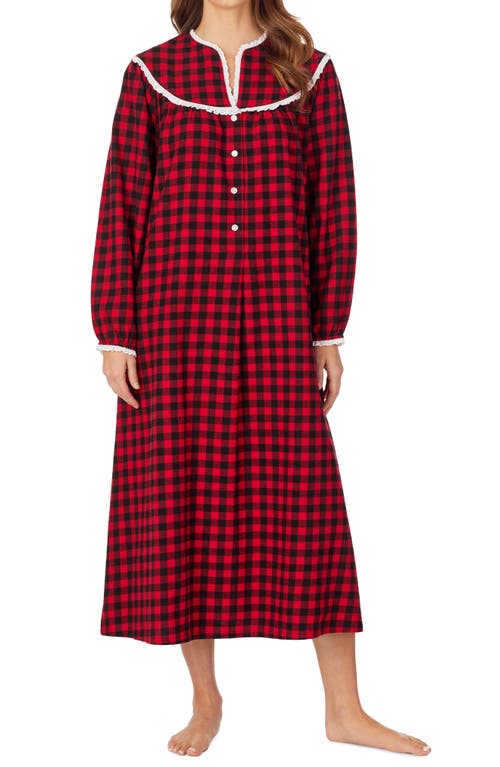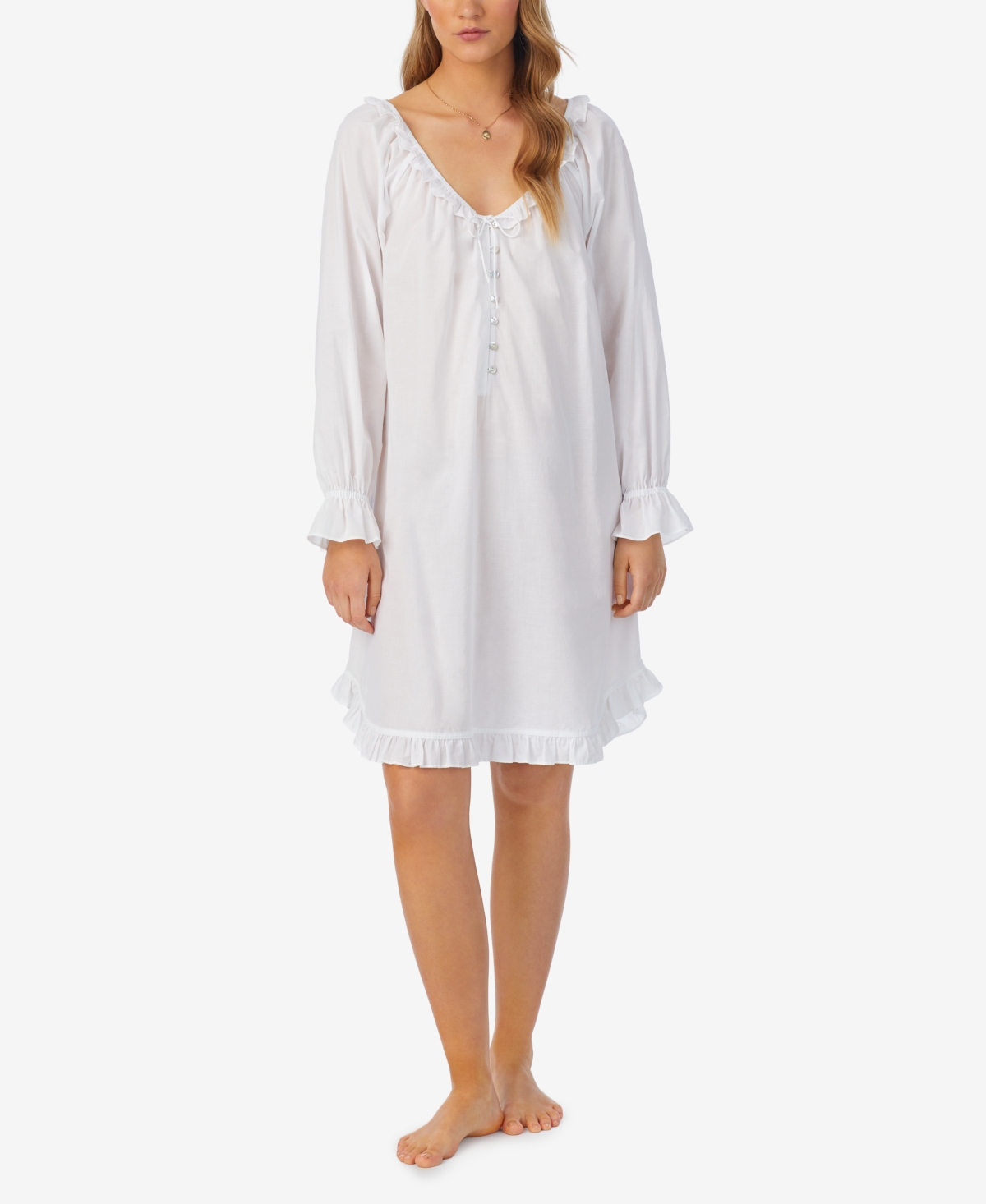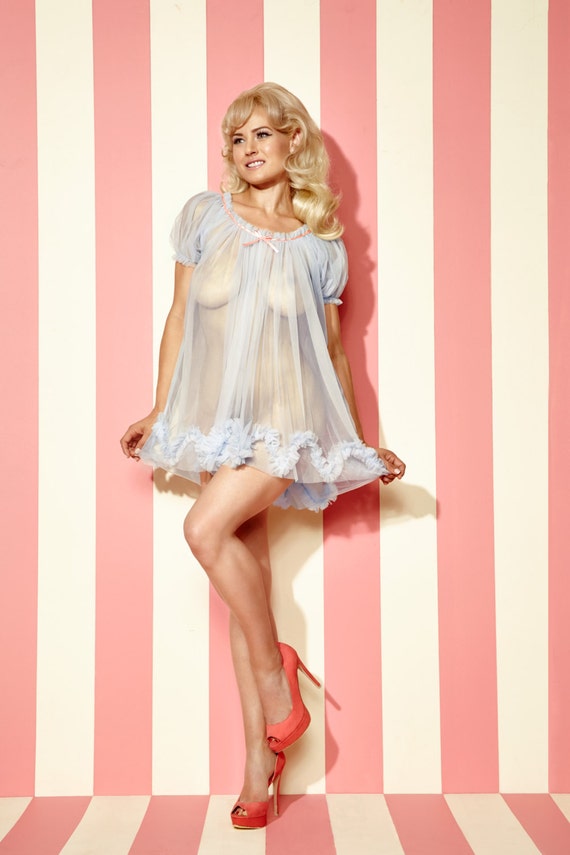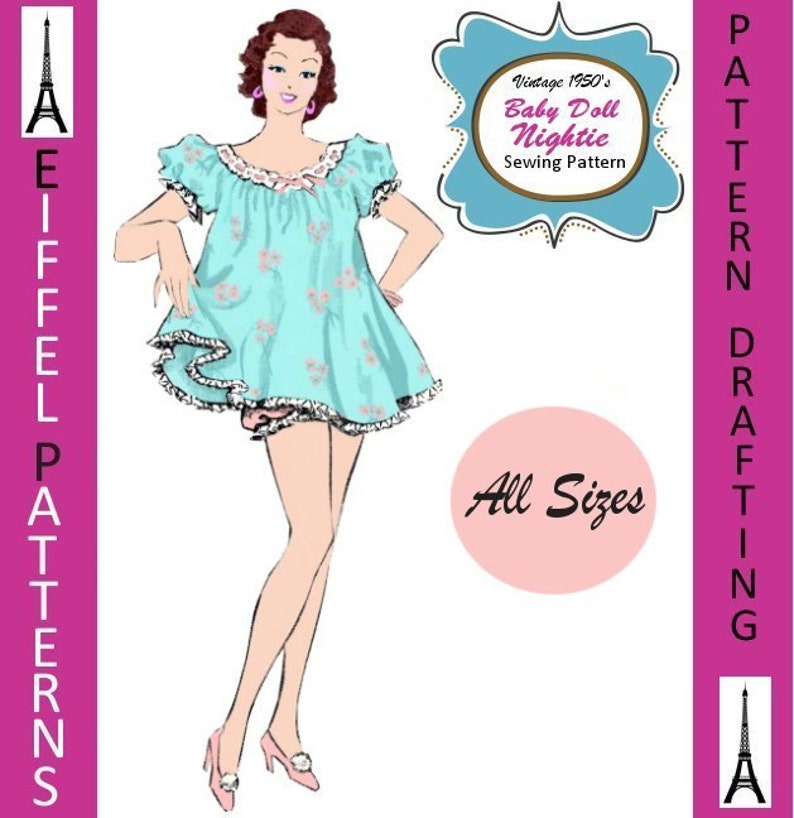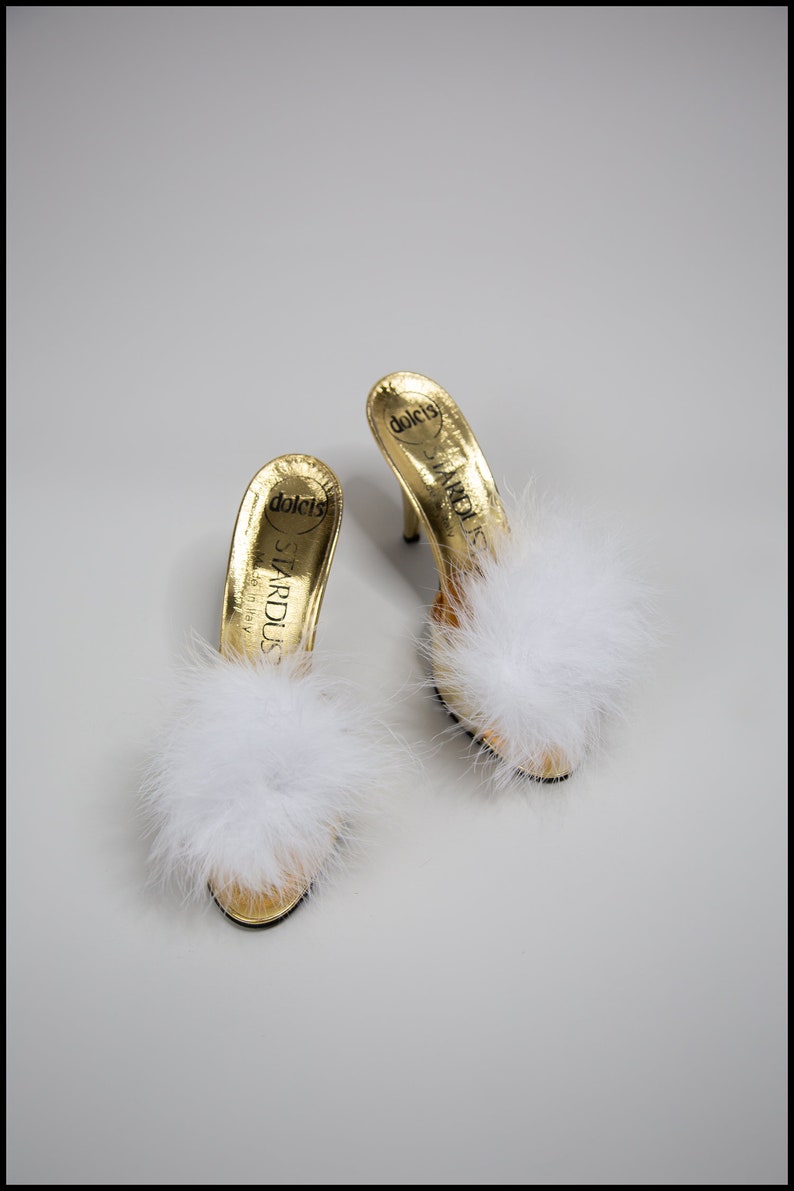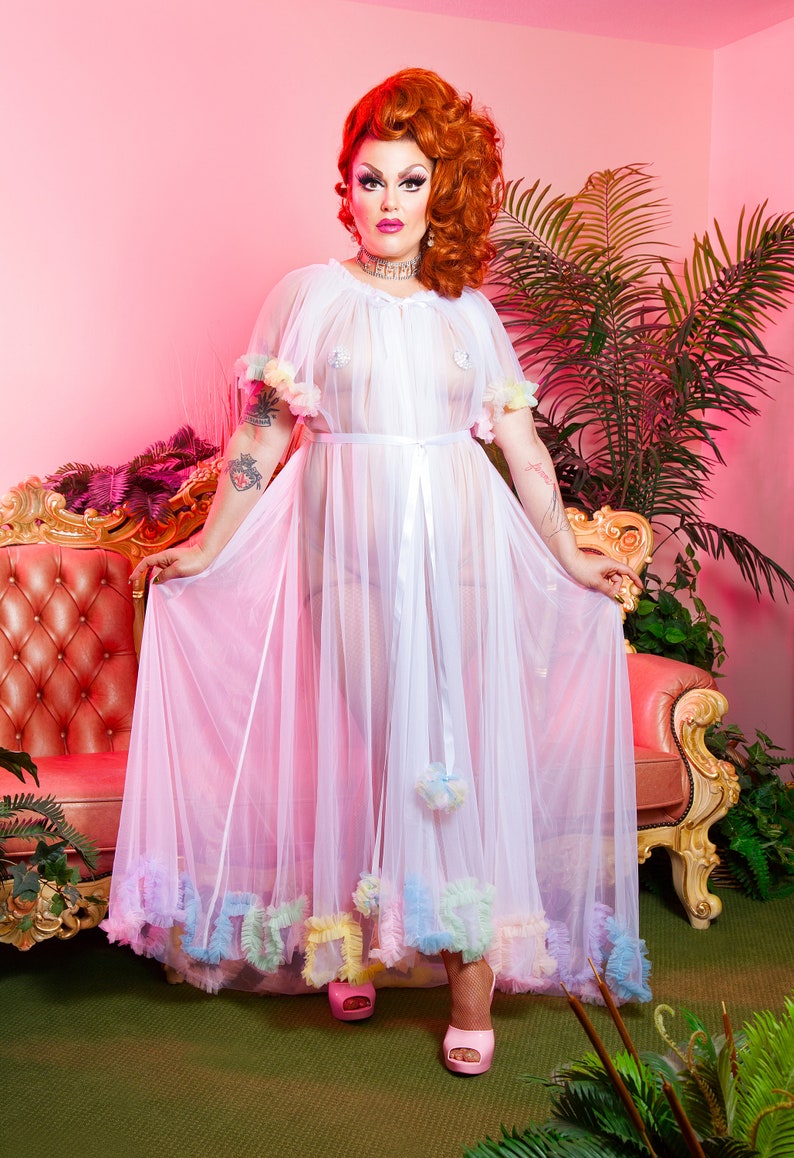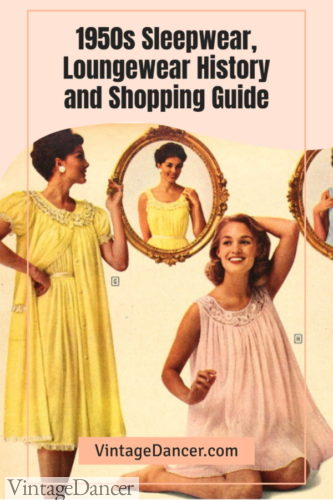
The 1950s saw new materials being utilized for nightwear, sleepwear, and lounge clothes- the most popular of which was Nylon. Although Nylon had been patented in the late 1930s, due to WWII it was not freely available again until the late 1940s.
By the 1950s, Nylon tricot fabric was used to make frilly nightgowns, slips, half-slips, and baby doll nighties. Rayon and satin lavishly trimmed in lace or decorated with embroidery made up the bulk of 1950s sleepwear in summer while heavy cotton and warm flannel made of most winter nightclothes.
1950s Nightgowns- Pink, Pastels
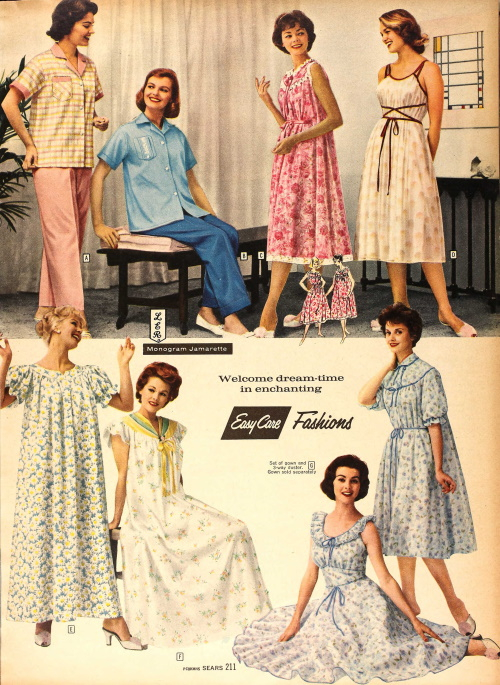
1959 sleepwear
The 50s nightgown was a very pretty bias-cut gown with an empire waist and no sleeves, cap sleeves, or long balloon sleeves. Vintage 1950s nightgowns came in tea lengths or long ankle length.
In the early 1950s, striped rayon in pink, blue, or peach were popular nightgown colors. The later 1950s years preferred solid pastels and floral cotton prints. They were very flattering and quite popular today for vintage nightgown collectors.
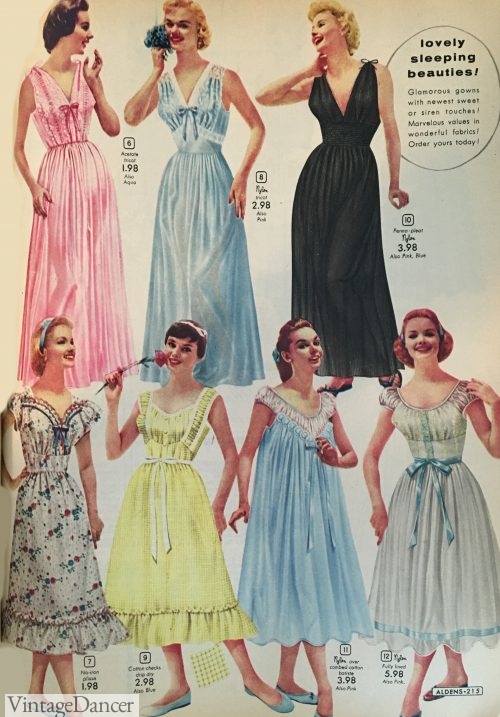
1950s princess nightgowns
1950s Winter Nightgowns
In winter, cotton or flannel fabric nightgowns and pajamas was warmer but also less pretty. Long sleeve winter nightgowns were ankle lengths with a high round neck and optional Peter Pan collar.
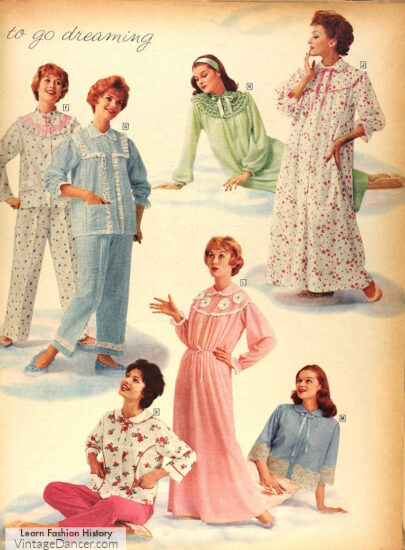
1959 winter sleepwear
Some winter 1950s nightgowns had a gathered waist, but most were pleated from the bust and draped down to the floor. They were sometimes called the “Mother Hubbard” nightgown for its nun-like appearance.
The inspiration for modest 1950s nightgowns was taken from the Victorian era, where long white gowns were embroidered and trimmed with delicate lace around the neckline.
- 1950 flannel pajamas
- 1955 flannel nightgowns
1950s Baby Doll Nightie
The vintage Babydoll nightie was popularized during this decade, featured in the 1956 movie Baby Doll, worn by Carroll Baker.
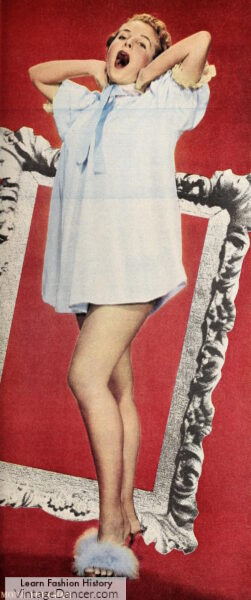
1951 baby doll nightie worn by Mona Freeman
The 1950s Baby Doll nightie was often sleeveless, fitted across the shoulders before skimming out over the body like a smock, falling to the upper thigh. It came with a matching pair of bloomer shorts ruffled and trimmed in lace. Lace and ruffles heavily decorated the round neckline and shoulders too.
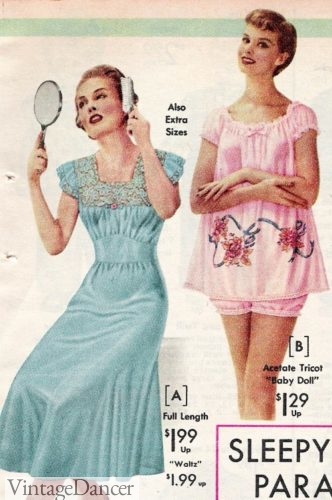
1957 long and short baby doll nighties
Some 50s Baby Doll nightie inspiration was taken from Court Jester or Pierrot clown costumes (can you see it?). Most were made of light cotton, but more sexy versions were made of rayon, satin and sheer chiffon (oh my!).
- 1958 Natalie Wood wears a babydoll nightie
- 1956 Rita Moreno wears a leopard print babydoll
- 1957 babydolls, pajamas
- 1958 Babydoll nighties
1950s Pajamas
The 1950s baby doll nightie was the preferred outfit in summer, while the two-piece pajama was common year-round. Despite the 1950s nightgown’s pretty looks and soft materials, it was losing favor as the decade progressed.
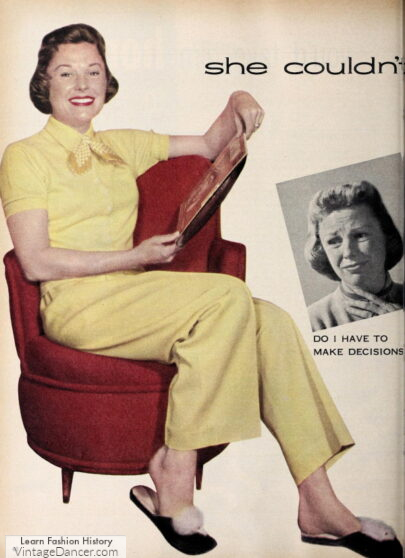
1956 yellow pajamas worn by June Allyson
Thanks to the Asian inspiration for Beach Pajamas in the 1930s, they experienced a revival in the bedroom in the 1950s. Belted pajamas sets, smock top pajamas, and shirt pajamas took on global influences.
- 1952 pajamas
- 1956 pajama styles
- 1957 cozy pajamas
- 1959 shirt pajamas
“Mandarin” pajamas were pajama shirts with coordinating wide leg pajama pants underneath. Asian elements like print buttons, collars, and robes embellished pajamas for most of the decade.
Other late 1950s pajamas style inspiration come from Italy, Switzerland, Norway, Austria and The Orient (China and Japan):
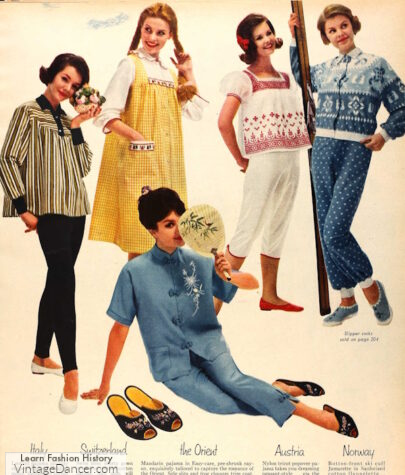
1959-196 global pajamas designs: Italy, Switzerland, the Orient, Austria and Norway
Other women’s 50s pajamas came in floral prints, candy stripes, polka dots, novelty themes, checks, and mod two-tone combinations. They could be made from light or heavy materials for the different seasons.
Some pajamas had tie belts and most had extra large patch pockets or a man style chest pocket. The difference between men’s and women’s pajamas by the end of the decade was minimal.
- 1959 mandarin pajama set
- Mandarin robe and pajamas
One emerging new style in the late 50s was the winter ski pajama. They looked like long underwear with a high ribbed neck, sleeve and leg cuffs. They fit slim but not too tight. Most came in Nordic winter-y prints, chevron stripes, and Christmas themes. Today’s old fashioned pajama selection isn’t very different than 50s styles.
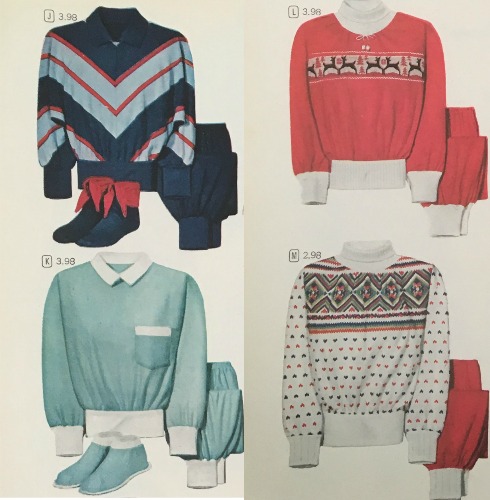
Late 1950s Ski pajamas
Matching Family Pajamas
Another trend that started in the 1950s was the matching family pajamas. The earliest ad I found was from 1955. Dressing mom, dad and kids in matching family pajamas became a holiday trend for Christmas morning. The designs leaned toward men’s style pajamas sized for the whole family.
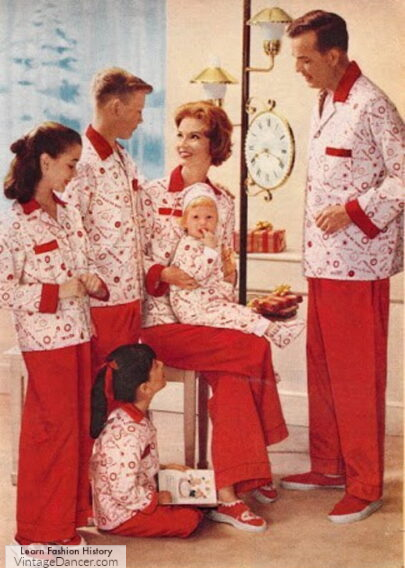
1959 Christmas Pajamas
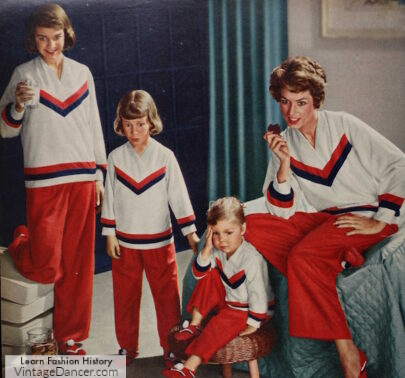
1959 Lounge Pajamas
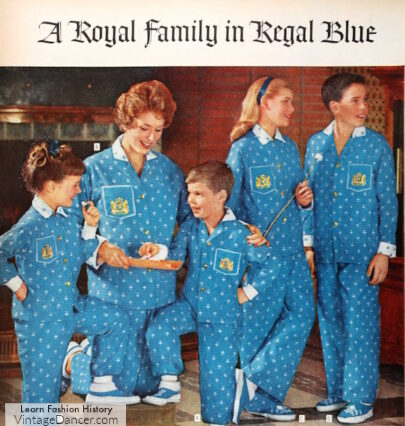
1959 Royal matching family pajamas
1950s Robes
While 1950s winter pajamas were modest, summer pajamas and nightgowns — especially baby dolls — were not. This made wearing a robe a requirement. Only in the bedroom alone (or with a spouse) was a woman allowed to remove her robe.
Even while sitting in bed reading, she was probably wearing a bed jacket. It was a short, chest length robe that covered the top half of her body. It could be sheer chiffon but was usually made of a warm quilted flannel. The topmost pictured bed jacket is knit into a bolero jacket, another warm option. They were very handy to wear while in bed or white doing a nighttime and morning beauty routine.
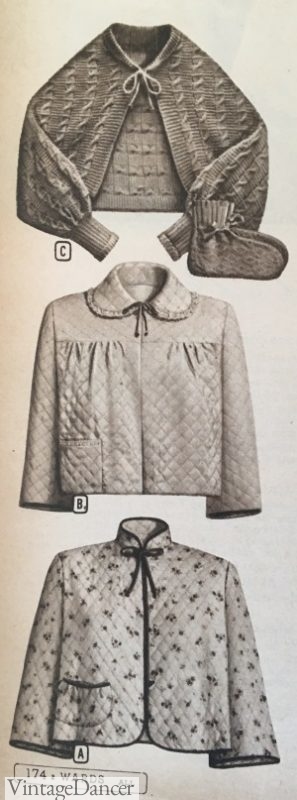
Bed Jackets. Knit or quilted
Full length or tea length robes were sold to match nightgowns and pajamas. The very soft Chenille robe was a perennial 50s favorite. So were Chenille bedspreads, bathroom rugs, and curtains.
Big, fluffy, warm, and colorful, they replaced the ’40s manly plaid robe, although the quilted robe was still popular. Light corduroy robes and terry cloth robes entered the picture in the late ’50s.
- 1950 chenille robes
- 1950s robes
1950s summer robes were made of light cotton, satin, rayon, or Nylon fabrics to match nightgowns. They fastened at the top with a button and bow or two tied ribbons and flared out like a tent from there.
Some 50s robes had tie belts to nip in the waist and large patch pockets.
Sleeves were short, just below the elbow or full wrist length.
The women’s 1950s robe fit was loose and modest yet with the a tea length were fresh and modern.
- 1957 robes and house coats
- 1957 quilted robes
1950s Peignoir Sets
A luxurious matching sheer robe and nightgown set, a peignoir set, was being fashioned by 1950s movie stars and TV actresses. A vintage peignoir was originally a light sheer or lace robe worn over a sleepwear, lingerie or morning clothes while doing ones hair and beauty routine.
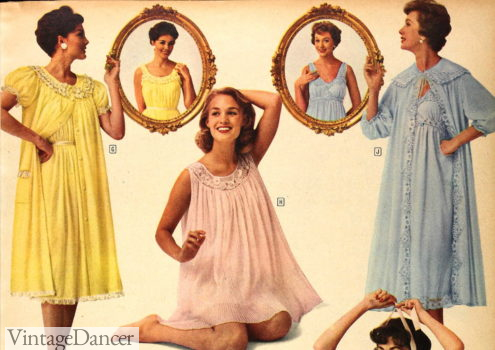
1959 Sears peignoir sets
In the 1950s, peignoir sets, were also worn for the morning routine but also around the house (if no company was visiting.)
The volumeus sheer tulle, net, nylons, lace and bits of fur or feathers adorned the robe. The nightgown underneath could be a short baby doll or a midi length or longer slip gown.
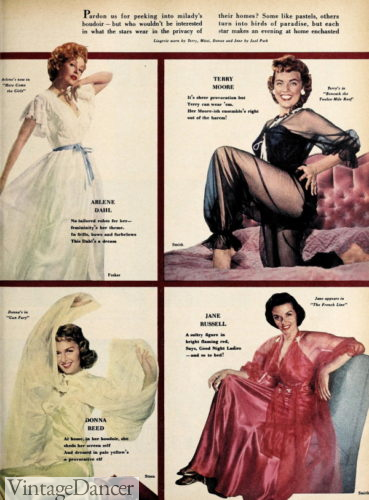
1953 movie star peignoir sets
Peignoir sets were very sexy and alluring. Popular magazines featured pinups and actresses in their elaborate peignoir sets, usually modeled over corsets and underwear.
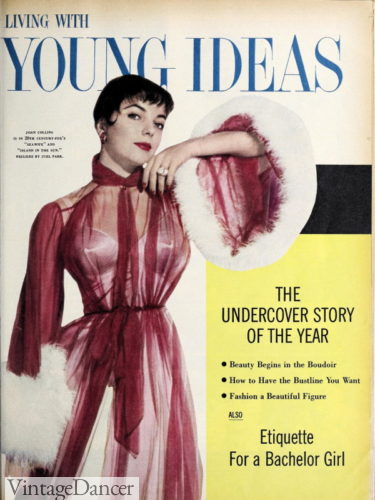
1956 Joan Collins feather trim peignoir robe
The peignoir set for the common housewife didn’t become a trendy item until 1959. They were hardly sheer enough to be see-through but maintain the look and shape of the sexier peignoir sets. most were made of Tricot, a fine light and soft nylon knit.
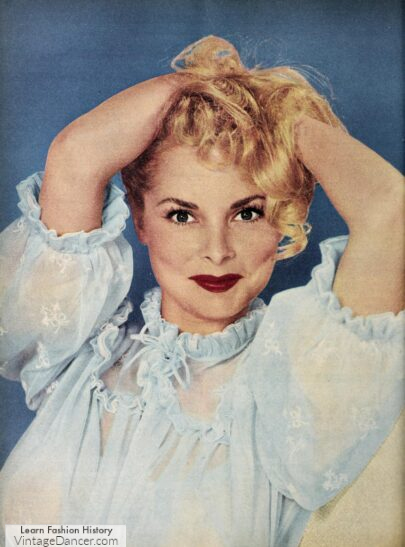
1954 blue peignoir set
Shop for vintage style robes and peignoir sets.
1950s Slippers
1950s house slippers were practical or romantic and never boring. Unlike today’s house slippers which seem to come in limited designs and colors, the 1950s house slipper had as much variety of women’s shoes.
In the 1950s there were slip on slippers, step in slippers, mule slippers, flats, pumps, loafers, moccasins, sandals, ballet flats and booties. Women’s 1950s house slippers could be made of soft leather lined in flannel or wool but more often were made in soft fabrics, fuzzy fleece, terry cloth, quilted velvet, felted wool and knitwear.
- 1952 fuzzy slippers
- 1952 boudoir slippers
- 1957 fuzzy slippers
- 1959 unique slippers
The most sought after boudoir slippers were the satin or leather mule heel slippers that may have been trimmed with soft rabbit fur or marabou feathers, flowers, pom poms and big buckles.
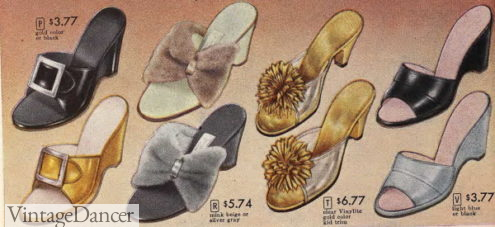
1957 fancy mule slippers
Shop Vintage Style 50s Sleepwear
Sexy or every nightgowns, baby doll nighties, peignoir sets, pajamas, robes and slippers in the 1950s style.
Debbie Sessions has been teaching fashion history and helping people dress for vintage themed events since 2009. She has turned a hobby into VintageDancer.com with hundreds of well researched articles and hand picked links to vintage inspired clothing online. She aims to make dressing accurately (or not) an affordable option for all. Oh, and she dances too.
